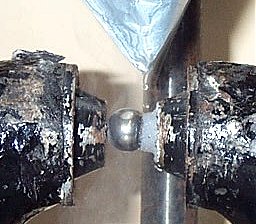| Electricity and
Magnetism > Magnetic Materials |
DCS# 5G30.20 |
PARAMAGNETISM
OF LIQUID OXYGEN

-
APPARATUS
strong C magnet or bar magnet
|
202-20-C |
| steel ball |
202-20-D5 |
| aluminum foil |
202-02-E1 |
| dewar |
101-01-B |
| liquid nitrogen |
Science Center dock |
| camera |
202-09-D |
black
cloth
|
202-01-C
|
DESCRIPTION
- An aluminum foil cone is filled
with liquid nitrogen. Liquid oxygen condenses on the
sides of the cone and drips between the poles of the magnet
where it sticks until it evaporates. Or use a strong bar
magnet to deflect the stream of dripping oxygen. Liquid
nitrogen can be poured into the magnet gap to show that it is
not paramagnetic.

- NOTES
- Place a steel ball
bearing on one of the magnet poles to reduce the size of the
gap. Fold aluminum foil into a cone and fill with liquid
nitrogen.
Hang the black cloth behind the magnet and/or illuminate the
LO2 with a maglight for better visibility.
- Boiling temperature of
liquid oxygen is -183° C (90K).
- Boiling temperature of liquid
nitrogen is -196° C (77K).
Molecular orbital theory shows that the triplet state of O2
(with outer shell electron spins parallel) has a lower energy
than the singlet state (with antiparallel spins forming part
of a double bond). So there are two unpaired electrons
in molecular oxygen.
-
REFERENCES
Sutton, H-11, E-102.
Freier and Anderson, Es-3.


